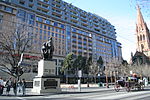The Capitol, Melbourne

The Capitol is an historic theatre on Swanston Street in the central business district (CBD) of Melbourne, Victoria, Australia. Opened in 1924 as part of the Capitol House building, the art deco theatre was designed by American husband and wife architects Walter Burley and Marion Mahony Griffin, and is the oldest of Melbourne's large picture palaces. It is famous for its extravagant decor and abstract motifs, including an intricate geometric ceiling containing thousands of coloured lamps, designed to evoke the walls of a crystalline cave. Proposals in the early 1960s to demolish the theatre sparked one of Australia's first major heritage conservation campaigns. While the cinema was saved, its seating capacity was reduced and parts of the original ground level foyer were replaced by a shopping arcade. RMIT University purchased The Capitol in 1999 for use as a lecture theatre, and in 2014 it was closed to undergo an extensive five-year restoration and upgrade. The Capitol reopened in 2019 and has since hosted various film festival screenings, theatrical performances and other events. The Capitol is registered with the Australian Heritage Council, the National Trust of Australia and Heritage Victoria, which describes its avant-garde design as "extremely unusual in the realm of theatres and cinemas worldwide" and "a technical triumph".
Excerpt from the Wikipedia article The Capitol, Melbourne (License: CC BY-SA 3.0, Authors, Images).The Capitol, Melbourne
Flinders Street, Melbourne Melbourne
Geographical coordinates (GPS) Address Nearby Places Show on map
Geographical coordinates (GPS)
| Latitude | Longitude |
|---|---|
| N -37.81536 ° | E 144.96636 ° |
Address
Town Hall (CBD South)
Flinders Street
3000 Melbourne, Melbourne
Victoria, Australia
Open on Google Maps










